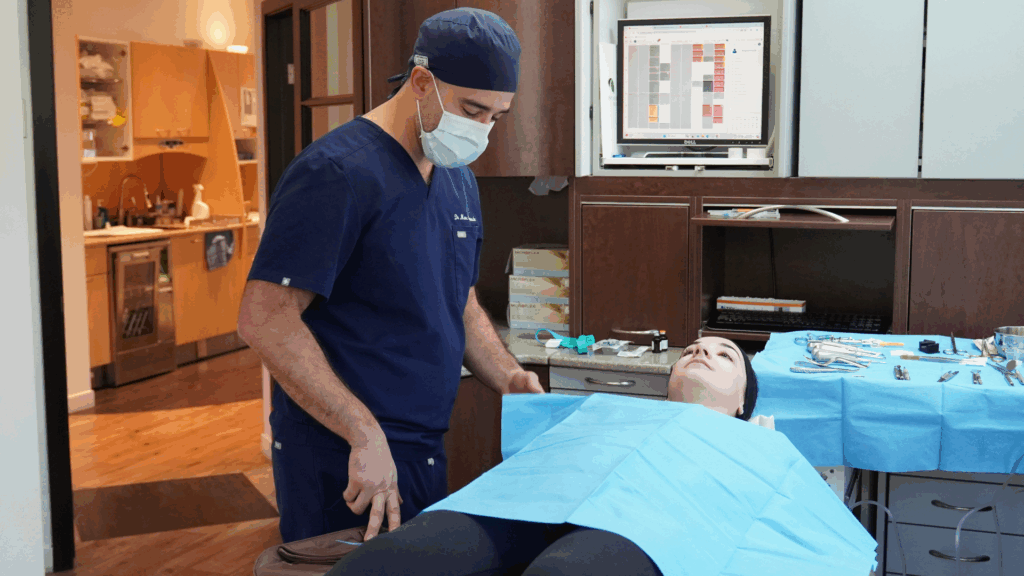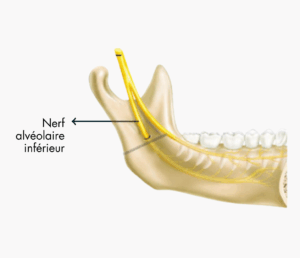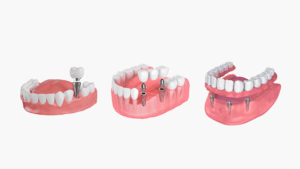Pourquoi l’extraction des dents de sagesse n’est pas une simple routine
Les dents de sagesse, aussi appelées troisièmes molaires, sont les dernières dents permanentes à faire leur apparition. Chez la plupart des gens, cela se produit entre 17 et 25 ans. Bien que certaines personnes n’aient aucun problème, d’autres rencontrent des complications telles que l’infection ou la douleur lorsque leurs dents de sagesse commencent à percer. Dans ces cas, l’extraction devient essentielle pour préserver la santé buccodentaire et éviter d’endommager les autres dents.
Même si l’extraction des dents de sagesse est une intervention chirurgicale courante, elle n’est pas sans risque. L’un des enjeux les plus importants, notamment lors de l’extraction des dents de sagesse inférieures, est la possibilité de lésions nerveuses. Dans de rares cas, les patients peuvent ressentir des changements de sensation dus à un contact ou un traumatisme nerveux pendant la chirurgie.
Cet article est un guide complet pour comprendre quels nerfs peuvent être à risque, comment les complications peuvent survenir et, surtout, comment les chirurgiens buccaux et maxillo-faciaux planifient et effectuent des extractions de dents efficaces et sécuritaires. Que vous vous prépariez pour une chirurgie ou que vous envisagiez vos options, la connaissance est votre meilleur outil pour une expérience positive.
Comprendre les dents de sagesse incluses et pourquoi les extraire
Que sont les dents de sagesse incluses?
Les dents de sagesse incluses sont des troisièmes molaires qui ne poussent pas dans la bonne position. Cela est souvent causé par un manque d’espace dans la mâchoire ou par l’interférence d’autres dents. En conséquence, les dents peuvent pousser de travers, rester coincées dans la gencive ou demeurer complètement enfermées dans l’os maxillaire.
Types d’inclusion :
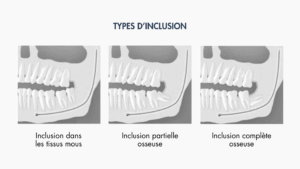
- Inclusion dans les tissus mous : la dent est recouverte par la gencive
- Inclusion partielle osseuse : une partie de la dent est prise dans l’os
- Inclusion complète osseuse : toute la dent est enfermée dans l’os
Ces situations sont plus que de simples inconvénients. Avec le temps, une dent incluse peut entraîner :
- Douleur et enflure
- Caries dans les molaires adjacentes
- Maladie des gencives due à un nettoyage difficile
- Formation de kystes ou de tumeurs dans l’alvéole dentaire
Si elles ne sont pas traitées, les dents de sagesse incluses peuvent aussi abîmer les racines des autres dents ou nuire à un traitement orthodontique.
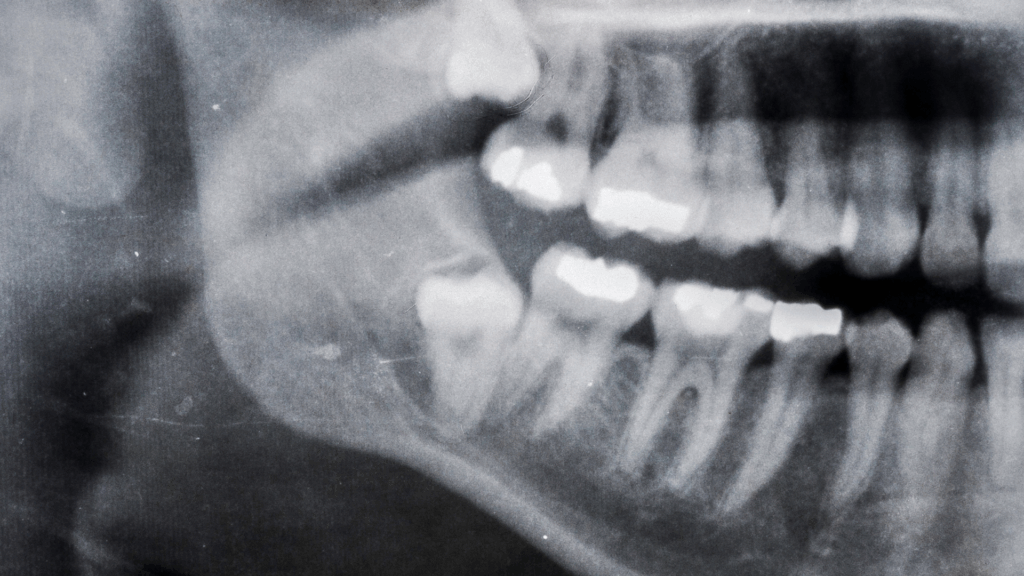
Pourquoi extraire les dents de sagesse incluses?
La décision d’extraire les dents de sagesse incluses est souvent guidée par une approche préventive. Les retirer avant que les complications n’apparaissent peut vous éviter des traitements plus complexes à l’avenir.
Avantages d’une extraction précoce :
- Moins de risque d’infection et d’alvéolite
- Temps de guérison plus court chez les jeunes
- Chirurgie plus simple
- Moins de risque de lésion nerveuse, surtout avant que les racines soient formées
Un chirurgien buccal expérimenté évaluera la position de vos troisièmes molaires, leur proximité aux nerfs avoisinants et la probabilité de complications futures. Si la dent cause déjà de la douleur ou une infection, une extraction rapide est souvent recommandée.
Quels nerfs sont à risque lors d’une extraction de dents de sagesse?
Lorsque les dents de sagesse inférieures sont extraites, surtout si elles sont profondément incluses, il existe un faible mais réel risque d’atteinte des nerfs de la mâchoire inférieure. Les deux nerfs concernés sont :
Nerf alvéolaire inférieur
Le nerf alvéolaire inférieur (NAI) chemine dans la mandibule et fournit la sensation à la lèvre inférieure, au menton et aux dents inférieures. Il est souvent très proche des racines des dents de sagesse inférieures, surtout lorsqu’elles sont incluses en profondeur.
Une blessure au NAI peut entraîner :
- Engourdissement ou picotements dans la lèvre inférieure ou le menton
- Sensation altérée dans la zone touchée
- Dans de rares cas, une lésion nerveuse permanente
Nerf lingual
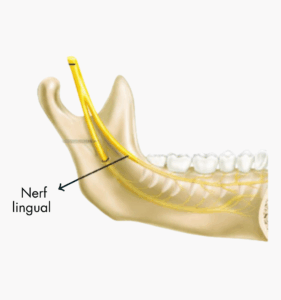
Le nerf lingual est situé près de la surface de la gencive, côté langue, à l’arrière des molaires inférieures. Il contrôle la sensation et le goût dans les deux tiers antérieurs de la langue. Bien qu’il soit moins souvent blessé, il peut être touché par les instruments chirurgicaux ou les incisions.
Une lésion au nerf lingual peut causer :
- Engourdissement ou picotements de la langue
- Diminution du goût ou goût altéré
- Sensation de brûlure ou douleur électrique dans la langue
Qui est plus à risque de lésion nerveuse lors d’une extraction?
Bien que les lésions nerveuses soient rares, certains facteurs augmentent les risques de complications pendant l’extraction.
Facteurs de risque :
- Inclusion profonde : la dent est très proche du nerf alvéolaire inférieur
- Âge avancé : l’os est plus dense et le tissu nerveux plus vulnérable
- Racines courbées ou en forme de crochet
- Absence d’imagerie préopératoire de qualité
Les patients avec ces facteurs peuvent présenter un risque plus élevé de complications, surtout si l’intervention est réalisée par un professionnel sans formation avancée en chirurgie buccale et maxillo-faciale.

Comment l’imagerie permet de réduire le risque de lésion nerveuse
L’imagerie diagnostique est l’un des outils les plus efficaces pour prévenir les lésions nerveuses lors de l’extraction.
Techniques d’imagerie courantes :
- Radiographie panoramique : vue générale en deux dimensions de la mâchoire
- Tomographie volumique à faisceau conique (CBCT) : images 3D en haute définition permettant de visualiser la dent et sa relation avec les nerfs
Ce niveau de précision permet au chirurgien buccal de planifier une approche plus sûre, ou d’adapter la technique chirurgicale, comme effectuer une coronectomie au lieu d’une extraction complète.
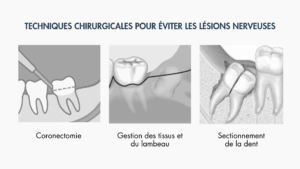
Techniques chirurgicales pour éviter les lésions nerveuses
Lorsque l’imagerie révèle un risque, les chirurgiens buccaux et maxillo-faciaux peuvent appliquer différentes techniques pour le minimiser.
1. Coronectomie
Si les racines sont en contact direct avec le nerf alvéolaire inférieur, le chirurgien peut recommander une coronectomie. Cette technique consiste à retirer uniquement la couronne de la dent, en laissant les racines en place pour éviter d’endommager le nerf.
2. Gestion des tissus et du lambeau
Lors de l’intervention, une manipulation soigneuse de la gencive et une planification stratégique du lambeau permettent de préserver le nerf lingual.
3. Sectionnement de la dent
Au lieu de retirer la dent en un seul morceau, le chirurgien peut la diviser en plusieurs parties afin d’en faciliter l’extraction et réduire les traumatismes.
Symptômes de lésion nerveuse après une extraction
Après une extraction chirurgicale, certains effets secondaires sont normaux pendant la guérison. Il est important de distinguer les symptômes classiques de récupération de ceux liés à une atteinte nerveuse.
Symptômes normaux :
- Enflure légère de la zone touchée
- Raideur ou sensibilité de la mâchoire
- Engourdissement temporaire pendant quelques heures (anesthésie locale)
- Fermeture graduelle de l’alvéole dentaire
Signes possibles de lésion nerveuse :
- Engourdissement ou picotement persistant au-delà de 10 à 14 jours
- Perte de sensation dans la lèvre inférieure, la langue ou le menton
- Altération du goût ou goût désagréable
- Douleur vive ou sensation électrique inhabituelle
Si ces symptômes persistent plusieurs semaines ou s’aggravent, consultez rapidement votre chirurgien pour évaluer les options de traitement.
Gérer et traiter une lésion nerveuse
Bien que les lésions nerveuses permanentes soient extrêmement rares, une intervention précoce est essentielle pour améliorer les résultats de la guérison. Si les symptômes d’une lésion nerveuse persistent, votre médecin peut vous suggérer:
- Médicaments anti-inflammatoires
- Suppléments de vitamine B
- Corticostéroïdes
- Évaluation neurologique si les symptômes persistent ou sont graves
- Chirurgie correctrice dans des cas extrêmement rares
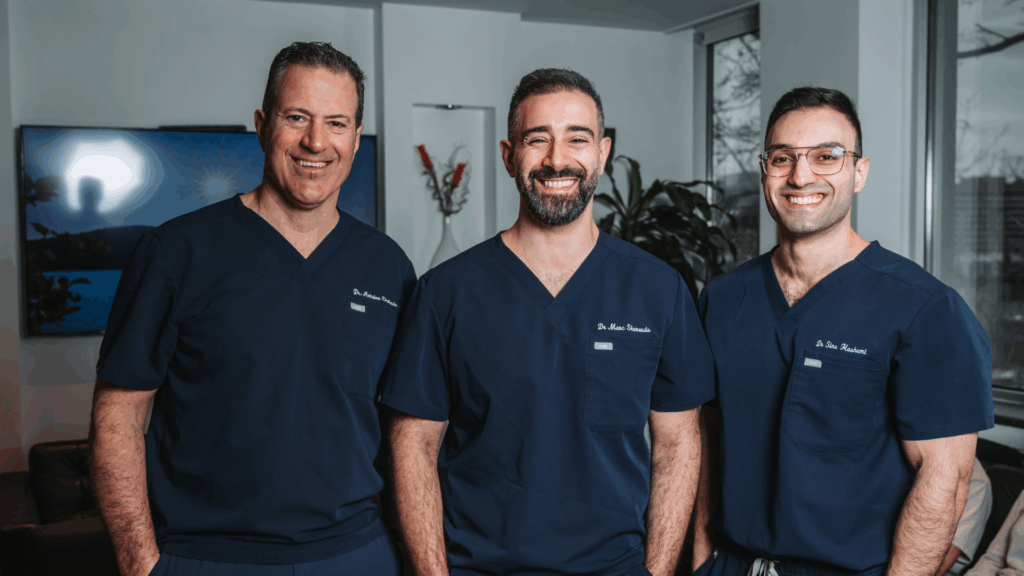
Quand consulter un spécialiste?
Toutes les extractions de dents de sagesse ne sont pas égales. Si votre dentiste général suspecte une complexité accrue, il peut vous orienter vers un chirurgien maxillo-facial. Vous devriez également consulter un spécialiste si :
- Vous ressentez des symptômes de lésion nerveuse
- Vous avez déjà eu des complications lors d’extractions passées
- L’imagerie montre une proximité avec le nerf alvéolaire inférieur ou le nerf lingual
- Vous souhaitez explorer des options chirurgicales avancées
Notre clinique à Montréal reçoit les patients pour des deuxièmes avis et des consultations personnalisées.
La sécurité commence par une bonne préparation
Il est normal de s’inquiéter avant une extraction de dents de sagesse. Heureusement, grâce à une planification rigoureuse, une imagerie avancée et l’expertise d’un chirurgien qualifié, l’intervention est extrêmement sûre. Les complications comme les lésions nerveuses ou l’alvéolite peuvent presque toujours être prévenues ou traitées efficacement.
En collaborant avec un spécialiste, en posant des questions sur l’imagerie comme la CBCT et en respectant votre plan de récupération, vous mettez toutes les chances de votre côté pour vivre une expérience positive et sans souci.
Pourquoi l’extraction des dents de sagesse n’est pas une simple routine
Les dents de sagesse, aussi appelées troisièmes molaires, sont les dernières dents permanentes à faire leur apparition. Chez la plupart des gens, cela se produit entre 17 et 25 ans. Bien que certaines personnes n’aient aucun problème, d’autres rencontrent des complications telles que l’infection ou la douleur lorsque leurs dents de sagesse commencent à percer. Dans ces cas, l’extraction devient essentielle pour préserver la santé buccodentaire et éviter d’endommager les autres dents.
Même si l’extraction des dents de sagesse est une intervention chirurgicale courante, elle n’est pas sans risque. L’un des enjeux les plus importants, notamment lors de l’extraction des dents de sagesse inférieures, est la possibilité de lésions nerveuses. Dans de rares cas, les patients peuvent ressentir des changements de sensation dus à un contact ou un traumatisme nerveux pendant la chirurgie.
Cet article est un guide complet pour comprendre quels nerfs peuvent être à risque, comment les complications peuvent survenir et, surtout, comment les chirurgiens buccaux et maxillo-faciaux planifient et effectuent des extractions de dents efficaces et sécuritaires. Que vous vous prépariez pour une chirurgie ou que vous envisagiez vos options, la connaissance est votre meilleur outil pour une expérience positive.
Comprendre les dents de sagesse incluses et pourquoi les extraire
Que sont les dents de sagesse incluses?
Les dents de sagesse incluses sont des troisièmes molaires qui ne poussent pas dans la bonne position. Cela est souvent causé par un manque d’espace dans la mâchoire ou par l’interférence d’autres dents. En conséquence, les dents peuvent pousser de travers, rester coincées dans la gencive ou demeurer complètement enfermées dans l’os maxillaire.
Types d’inclusion :

- Inclusion dans les tissus mous : la dent est recouverte par la gencive
- Inclusion partielle osseuse : une partie de la dent est prise dans l’os
- Inclusion complète osseuse : toute la dent est enfermée dans l’os
Ces situations sont plus que de simples inconvénients. Avec le temps, une dent incluse peut entraîner :
- Douleur et enflure
- Caries dans les molaires adjacentes
- Maladie des gencives due à un nettoyage difficile
- Formation de kystes ou de tumeurs dans l’alvéole dentaire
Si elles ne sont pas traitées, les dents de sagesse incluses peuvent aussi abîmer les racines des autres dents ou nuire à un traitement orthodontique.

Pourquoi extraire les dents de sagesse incluses?
La décision d’extraire les dents de sagesse incluses est souvent guidée par une approche préventive. Les retirer avant que les complications n’apparaissent peut vous éviter des traitements plus complexes à l’avenir.
Avantages d’une extraction précoce :
- Moins de risque d’infection et d’alvéolite
- Temps de guérison plus court chez les jeunes
- Chirurgie plus simple
- Moins de risque de lésion nerveuse, surtout avant que les racines soient formées
Un chirurgien buccal expérimenté évaluera la position de vos troisièmes molaires, leur proximité aux nerfs avoisinants et la probabilité de complications futures. Si la dent cause déjà de la douleur ou une infection, une extraction rapide est souvent recommandée.
Quels nerfs sont à risque lors d’une extraction de dents de sagesse?
Lorsque les dents de sagesse inférieures sont extraites, surtout si elles sont profondément incluses, il existe un faible mais réel risque d’atteinte des nerfs de la mâchoire inférieure. Les deux nerfs concernés sont :
Nerf alvéolaire inférieur
Le nerf alvéolaire inférieur (NAI) chemine dans la mandibule et fournit la sensation à la lèvre inférieure, au menton et aux dents inférieures. Il est souvent très proche des racines des dents de sagesse inférieures, surtout lorsqu’elles sont incluses en profondeur.
Une blessure au NAI peut entraîner :
- Engourdissement ou picotements dans la lèvre inférieure ou le menton
- Sensation altérée dans la zone touchée
- Dans de rares cas, une lésion nerveuse permanente
Nerf lingual

Le nerf lingual est situé près de la surface de la gencive, côté langue, à l’arrière des molaires inférieures. Il contrôle la sensation et le goût dans les deux tiers antérieurs de la langue. Bien qu’il soit moins souvent blessé, il peut être touché par les instruments chirurgicaux ou les incisions.
Une lésion au nerf lingual peut causer :
- Engourdissement ou picotements de la langue
- Diminution du goût ou goût altéré
- Sensation de brûlure ou douleur électrique dans la langue
Qui est plus à risque de lésion nerveuse lors d’une extraction?
Bien que les lésions nerveuses soient rares, certains facteurs augmentent les risques de complications pendant l’extraction.
Facteurs de risque :
- Inclusion profonde : la dent est très proche du nerf alvéolaire inférieur
- Âge avancé : l’os est plus dense et le tissu nerveux plus vulnérable
- Racines courbées ou en forme de crochet
- Absence d’imagerie préopératoire de qualité
Les patients avec ces facteurs peuvent présenter un risque plus élevé de complications, surtout si l’intervention est réalisée par un professionnel sans formation avancée en chirurgie buccale et maxillo-faciale.

Comment l’imagerie permet de réduire le risque de lésion nerveuse
L’imagerie diagnostique est l’un des outils les plus efficaces pour prévenir les lésions nerveuses lors de l’extraction.
Techniques d’imagerie courantes :
- Radiographie panoramique : vue générale en deux dimensions de la mâchoire
- Tomographie volumique à faisceau conique (CBCT) : images 3D en haute définition permettant de visualiser la dent et sa relation avec les nerfs
Ce niveau de précision permet au chirurgien buccal de planifier une approche plus sûre, ou d’adapter la technique chirurgicale, comme effectuer une coronectomie au lieu d’une extraction complète.

Techniques chirurgicales pour éviter les lésions nerveuses
Lorsque l’imagerie révèle un risque, les chirurgiens buccaux et maxillo-faciaux peuvent appliquer différentes techniques pour le minimiser.
1. Coronectomie
Si les racines sont en contact direct avec le nerf alvéolaire inférieur, le chirurgien peut recommander une coronectomie. Cette technique consiste à retirer uniquement la couronne de la dent, en laissant les racines en place pour éviter d’endommager le nerf.
2. Gestion des tissus et du lambeau
Lors de l’intervention, une manipulation soigneuse de la gencive et une planification stratégique du lambeau permettent de préserver le nerf lingual.
3. Sectionnement de la dent
Au lieu de retirer la dent en un seul morceau, le chirurgien peut la diviser en plusieurs parties afin d’en faciliter l’extraction et réduire les traumatismes.
Symptômes de lésion nerveuse après une extraction
Après une extraction chirurgicale, certains effets secondaires sont normaux pendant la guérison. Il est important de distinguer les symptômes classiques de récupération de ceux liés à une atteinte nerveuse.
Symptômes normaux :
- Enflure légère de la zone touchée
- Raideur ou sensibilité de la mâchoire
- Engourdissement temporaire pendant quelques heures (anesthésie locale)
- Fermeture graduelle de l’alvéole dentaire
Signes possibles de lésion nerveuse :
- Engourdissement ou picotement persistant au-delà de 10 à 14 jours
- Perte de sensation dans la lèvre inférieure, la langue ou le menton
- Altération du goût ou goût désagréable
- Douleur vive ou sensation électrique inhabituelle
Si ces symptômes persistent plusieurs semaines ou s’aggravent, consultez rapidement votre chirurgien pour évaluer les options de traitement.
Gérer et traiter une lésion nerveuse
Bien que les lésions nerveuses permanentes soient extrêmement rares, une intervention précoce est essentielle pour améliorer les résultats de la guérison. Si les symptômes d’une lésion nerveuse persistent, votre médecin peut vous suggérer:
- Médicaments anti-inflammatoires
- Suppléments de vitamine B
- Corticostéroïdes
- Évaluation neurologique si les symptômes persistent ou sont graves
- Chirurgie correctrice dans des cas extrêmement rares

Quand consulter un spécialiste?
Toutes les extractions de dents de sagesse ne sont pas égales. Si votre dentiste général suspecte une complexité accrue, il peut vous orienter vers un chirurgien maxillo-facial. Vous devriez également consulter un spécialiste si :
- Vous ressentez des symptômes de lésion nerveuse
- Vous avez déjà eu des complications lors d’extractions passées
- L’imagerie montre une proximité avec le nerf alvéolaire inférieur ou le nerf lingual
- Vous souhaitez explorer des options chirurgicales avancées
Notre clinique à Montréal reçoit les patients pour des deuxièmes avis et des consultations personnalisées.
La sécurité commence par une bonne préparation
Il est normal de s’inquiéter avant une extraction de dents de sagesse. Heureusement, grâce à une planification rigoureuse, une imagerie avancée et l’expertise d’un chirurgien qualifié, l’intervention est extrêmement sûre. Les complications comme les lésions nerveuses ou l’alvéolite peuvent presque toujours être prévenues ou traitées efficacement.
En collaborant avec un spécialiste, en posant des questions sur l’imagerie comme la CBCT et en respectant votre plan de récupération, vous mettez toutes les chances de votre côté pour vivre une expérience positive et sans souci.


